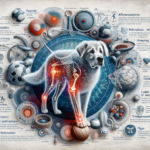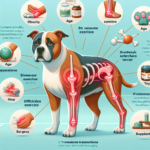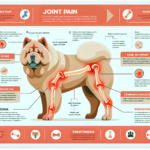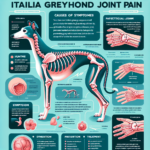Komondor Joint Pain: Causes, Symptoms, Prevention, and Treatment

Introduction
The Komondor, often referred to as the “Hungarian Sheepdog,” is a distinctive and ancient breed known for its unique corded coat. Originating from Hungary, the Komondor was primarily used to guard livestock, a role it performed with great diligence and bravery. This breed is characterized by its large size, muscular build, and a coat that forms natural cords, providing protection against harsh weather and predators. Despite their imposing appearance, Komondors are known for their loyalty and protective nature towards their families.
Like many large breeds, Komondors are prone to certain health issues, with joint pain being a significant concern. Joint health is crucial for maintaining the mobility and quality of life of these dogs, especially given their size and the physical demands of their traditional roles. Understanding the causes, symptoms, prevention, and treatment of joint pain in Komondors is essential for owners to ensure their pets lead healthy and active lives.
Breed-Specific Joint Pain Risks
Genetic Predisposition
Komondors, like many large breeds, have a genetic predisposition to joint-related issues. Hip dysplasia, a condition where the hip joint doesn’t fit properly into the hip socket, is particularly common. This can lead to arthritis and significant pain over time. Elbow dysplasia, another genetic condition, affects the elbow joints and can cause similar issues. These conditions are often inherited, making it crucial for breeders to screen for these problems to reduce their prevalence in the breed.
Age-Related Risks
As Komondors age, the risk of developing joint pain increases. The wear and tear on their joints over the years can lead to conditions like osteoarthritis. Owners should be particularly vigilant as their Komondor reaches middle age, typically around 5-7 years old, as this is when joint issues often begin to manifest. Regular veterinary check-ups can help catch these problems early and manage them effectively.
Activity Level and Joint Stress
Komondors are active dogs that require regular exercise to stay healthy. However, their large size and the physical demands of their traditional roles can put significant stress on their joints. Activities such as running, jumping, and guarding can exacerbate joint issues, especially if the dog is not conditioned properly. It’s important to balance their need for exercise with the potential for joint stress, ensuring they remain active without overexerting themselves.
Common Symptoms of Joint Pain in Komondors
General Symptoms
Owners should be aware of several common symptoms of joint pain in Komondors:
- Limping: One of the most noticeable signs, limping can indicate pain in one or more joints.
- Stiffness: Particularly after rest or sleep, stiffness can be a sign of joint discomfort.
- Reluctance to Move: A dog that is hesitant to climb stairs, jump, or even go for walks may be experiencing joint pain.
- Swelling: Visible swelling around the joints can indicate inflammation and pain.
- Behavioral Changes: Increased irritability or changes in behavior can be a response to chronic pain.
Breed-Specific Symptoms
In Komondors, specific symptoms may be more pronounced due to their size and coat. For instance, their heavy coat can sometimes mask swelling, making it harder to detect. Owners should pay close attention to subtle changes in movement and behavior, as these can be early indicators of joint pain.
When to Consult a Vet
If any of the above symptoms are observed, it’s important to consult a veterinarian promptly. Early intervention can prevent further deterioration and improve the dog’s quality of life. Regular check-ups are also essential, especially as the dog ages, to monitor joint health and catch any issues early.
Preventive Measures for Joint Health
Exercise Recommendations
Maintaining an appropriate exercise regimen is crucial for Komondors. Low-impact activities such as walking and swimming are excellent for keeping their joints healthy without causing excessive stress. Avoid high-impact activities like jumping or running on hard surfaces, which can exacerbate joint issues. Regular, moderate exercise helps maintain muscle mass and joint flexibility.
Dietary Suggestions
A balanced diet rich in essential nutrients is vital for joint health. Foods containing glucosamine and chondroitin can support joint function and repair. Omega-3 fatty acids, found in fish oil, have anti-inflammatory properties that can help reduce joint pain. Consult with a veterinarian to determine the best diet and supplements for your Komondor.
Weight Management
Maintaining a healthy weight is crucial for reducing joint stress. Excess weight puts additional pressure on the joints, exacerbating pain and leading to further complications. Regular exercise and a balanced diet are key to keeping your Komondor at an optimal weight. Monitor their weight regularly and adjust their diet and exercise routine as needed.
Early Screening and Monitoring
Early screening for joint issues can help catch problems before they become severe. Regular veterinary check-ups should include joint assessments, especially as the dog ages. X-rays and other diagnostic tools can help identify issues like hip or elbow dysplasia early on, allowing for timely intervention and management.
Treatment Options for Joint Pain
Non-Surgical Treatments
Several non-surgical treatments can help manage joint pain in Komondors:
- Medications: Anti-inflammatory drugs and pain relievers can help manage pain and reduce inflammation.
- Physical Therapy: Exercises and therapies designed to improve joint function and reduce pain can be highly effective.
- Lifestyle Adjustments: Modifying the dog’s activity level and environment to reduce joint stress can make a significant difference.
Surgical Options
In severe cases, surgical intervention may be necessary. Common surgeries for joint issues include:
- Hip Replacement: Replacing the damaged hip joint with an artificial one can significantly improve mobility and reduce pain.
- Arthroscopy: A minimally invasive procedure to clean out the joint and remove damaged tissue.
- Osteotomy: Cutting and realigning bones to improve joint function and reduce pain.
Surgical options should be discussed thoroughly with a veterinarian to determine the best course of action for your Komondor.
Alternative Therapies
Alternative therapies can also provide relief for joint pain:
- Acupuncture: This ancient practice can help reduce pain and improve joint function.
- Hydrotherapy: Water-based exercises can improve mobility and reduce pain without putting stress on the joints.
- Massage: Regular massage can help reduce muscle tension and improve circulation, benefiting joint health.
Lifestyle and Management Tips
Daily Care Routine
A consistent daily care routine can help manage joint pain in Komondors:
- Regular Exercise: Incorporate low-impact activities like walking and swimming into their daily routine.
- Balanced Diet: Ensure they receive a diet rich in essential nutrients and supplements for joint health.
- Weight Monitoring: Regularly check their weight and adjust their diet and exercise as needed.
- Joint Supplements: Consider adding glucosamine, chondroitin, and omega-3 supplements to their diet.
Modifying the Home Environment
Making the home environment more comfortable can significantly improve the quality of life for a Komondor with joint pain:
- Ramps: Use ramps instead of stairs to reduce joint stress.
- Orthopedic Beds: Provide a comfortable, supportive bed to reduce pressure on the joints.
- Non-Slip Flooring: Ensure floors are non-slip to prevent falls and further joint damage.
Long-Term Management
Long-term management strategies are essential for keeping your Komondor active and happy despite joint pain:
- Regular Vet Visits: Schedule regular check-ups to monitor joint health and adjust treatment plans as needed.
- Consistent Routine: Maintain a consistent exercise and care routine to manage pain and improve mobility.
- Supportive Therapies: Continue with physical therapy, hydrotherapy, or other supportive treatments as recommended by your vet.
FAQs About Komondors and Joint Pain
What are the early signs of joint pain in Komondors?
Early signs include limping, stiffness, reluctance to move, and behavioral changes such as increased irritability. If you notice any of these symptoms, consult your veterinarian promptly.
Can joint pain in Komondors be prevented?
While genetic predispositions cannot be entirely prevented, maintaining a healthy weight, providing a balanced diet, and ensuring regular, low-impact exercise can significantly reduce the risk of joint pain.
Are there specific diets that can help with joint health?
Yes, diets rich in glucosamine, chondroitin, and omega-3 fatty acids can support joint health. Consult with your veterinarian to determine the best diet and supplements for your Komondor.
When should I consider surgery for my Komondor’s joint pain?
Surgery should be considered when non-surgical treatments are no longer effective, and the dog’s quality of life is significantly impacted. Discuss surgical options thoroughly with your veterinarian to determine the best course of action.
What alternative therapies are effective for joint pain in Komondors?
Alternative therapies such as acupuncture, hydrotherapy, and massage can provide significant relief for joint pain. These therapies can be used in conjunction with traditional treatments for optimal results.
Conclusion
Joint pain is a common issue in Komondors, but with proper care and management, it can be effectively controlled. Understanding the causes, symptoms, prevention, and treatment options is crucial for ensuring your Komondor leads a healthy and active life. Regular veterinary check-ups, a balanced diet, appropriate exercise, and early intervention are key to maintaining joint health. By taking these preventive measures and consulting with your veterinarian regularly, you can help your Komondor enjoy a pain-free and fulfilling life.




